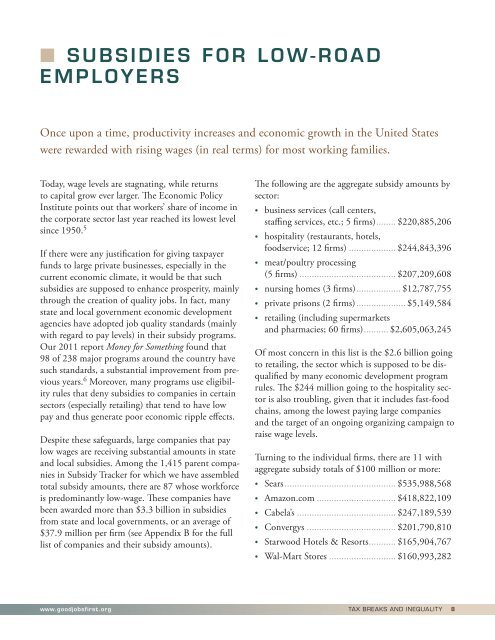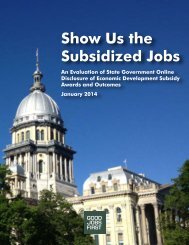and Inequality
phk5x5h
phk5x5h
Create successful ePaper yourself
Turn your PDF publications into a flip-book with our unique Google optimized e-Paper software.
n SUBSIDIES FOR LOW-ROAD<br />
EMPLOYERS<br />
Once upon a time, productivity increases <strong>and</strong> economic growth in the United States<br />
were rewarded with rising wages (in real terms) for most working families.<br />
Today, wage levels are stagnating, while returns<br />
to capital grow ever larger. The Economic Policy<br />
Institute points out that workers’ share of income in<br />
the corporate sector last year reached its lowest level<br />
since 1950. 5<br />
If there were any justification for giving taxpayer<br />
funds to large private businesses, especially in the<br />
current economic climate, it would be that such<br />
subsidies are supposed to enhance prosperity, mainly<br />
through the creation of quality jobs. In fact, many<br />
state <strong>and</strong> local government economic development<br />
agencies have adopted job quality st<strong>and</strong>ards (mainly<br />
with regard to pay levels) in their subsidy programs.<br />
Our 2011 report Money for Something found that<br />
98 of 238 major programs around the country have<br />
such st<strong>and</strong>ards, a substantial improvement from previous<br />
years. 6 Moreover, many programs use eligibility<br />
rules that deny subsidies to companies in certain<br />
sectors (especially retailing) that tend to have low<br />
pay <strong>and</strong> thus generate poor economic ripple effects.<br />
Despite these safeguards, large companies that pay<br />
low wages are receiving substantial amounts in state<br />
<strong>and</strong> local subsidies. Among the 1,415 parent companies<br />
in Subsidy Tracker for which we have assembled<br />
total subsidy amounts, there are 87 whose workforce<br />
is predominantly low-wage. These companies have<br />
been awarded more than $3.3 billion in subsidies<br />
from state <strong>and</strong> local governments, or an average of<br />
$37.9 million per firm (see Appendix B for the full<br />
list of companies <strong>and</strong> their subsidy amounts).<br />
The following are the aggregate subsidy amounts by<br />
sector:<br />
• business services (call centers,<br />
staffing services, etc.; 5 firms)......... $220,885,206<br />
• hospitality (restaurants, hotels,<br />
foodservice; 12 firms).................... $244,843,396<br />
• meat/poultry processing<br />
(5 firms)........................................ $207,209,608<br />
• nursing homes (3 firms)................... $12,787,755<br />
• private prisons (2 firms)..................... $5,149,584<br />
• retailing (including supermarkets<br />
<strong>and</strong> pharmacies; 60 firms)........... $2,605,063,245<br />
Of most concern in this list is the $2.6 billion going<br />
to retailing, the sector which is supposed to be disqualified<br />
by many economic development program<br />
rules. The $244 million going to the hospitality sector<br />
is also troubling, given that it includes fast-food<br />
chains, among the lowest paying large companies<br />
<strong>and</strong> the target of an ongoing organizing campaign to<br />
raise wage levels.<br />
Turning to the individual firms, there are 11 with<br />
aggregate subsidy totals of $100 million or more:<br />
• Sears.............................................. $535,988,568<br />
• Amazon.com................................. $418,822,109<br />
• Cabela’s......................................... $247,189,539<br />
• Convergys..................................... $201,790,810<br />
• Starwood Hotels & Resorts............ $165,904,767<br />
• Wal-Mart Stores............................ $160,993,282<br />
www.goodjobsfirst.org<br />
TAX BREAKS AND INEQUALITY 8



